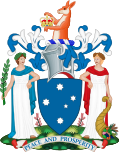Parliament House, Melbourne

Parliament House is the meeting place of the Parliament of Victoria, one of the parliaments of the Australian states and territories. Located on Spring Street on the edge of the Hoddle Grid, the grand colonnaded front dominates the vista up Bourke Street. Construction began in 1855, and the first stage was officially opened the following year, with various sections completed over the following decades; it has never been completed, and the planned dome is one of the most well known unbuilt features of Melbourne. Between 1901 and 1927, it served as the meeting place of the Parliament of Australia, during the period when Melbourne was the temporary national capital. The building is listed on the Victorian Heritage Register.
Excerpt from the Wikipedia article Parliament House, Melbourne (License: CC BY-SA 3.0, Authors, Images).Parliament House, Melbourne
Spring Street, Melbourne East Melbourne
Geographical coordinates (GPS) Address Phone number Website External links Nearby Places Show on map
Geographical coordinates (GPS)
| Latitude | Longitude |
|---|---|
| N -37.811055 ° | E 144.97329 ° |
Address
Parliament House
Spring Street
3000 Melbourne, East Melbourne
Victoria, Australia
Open on Google Maps











